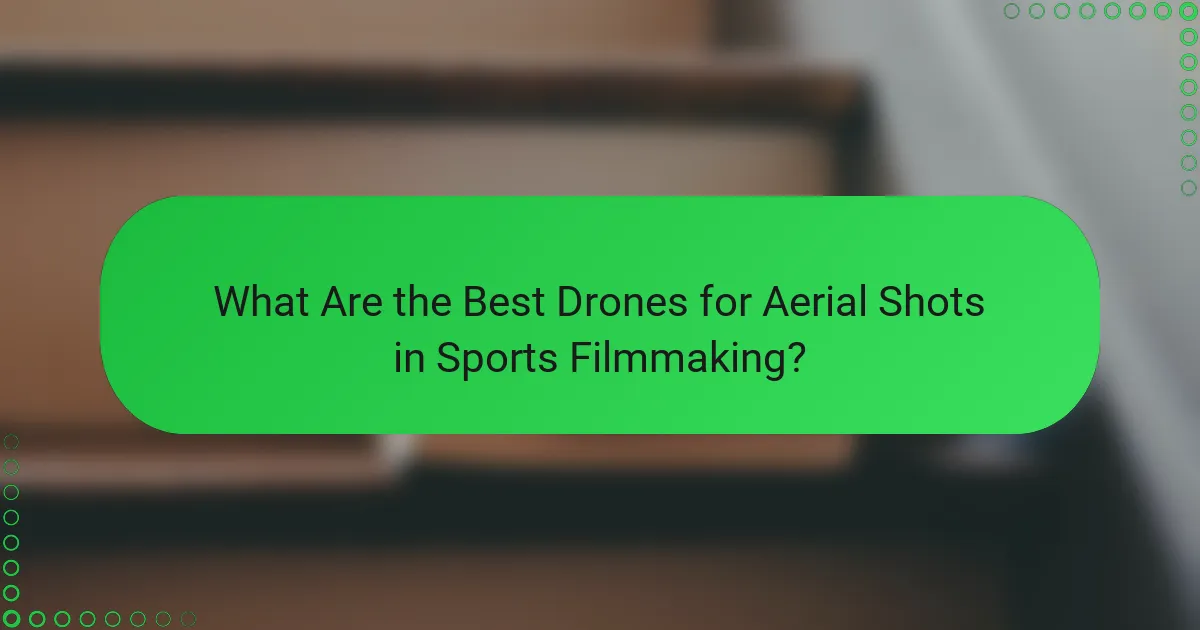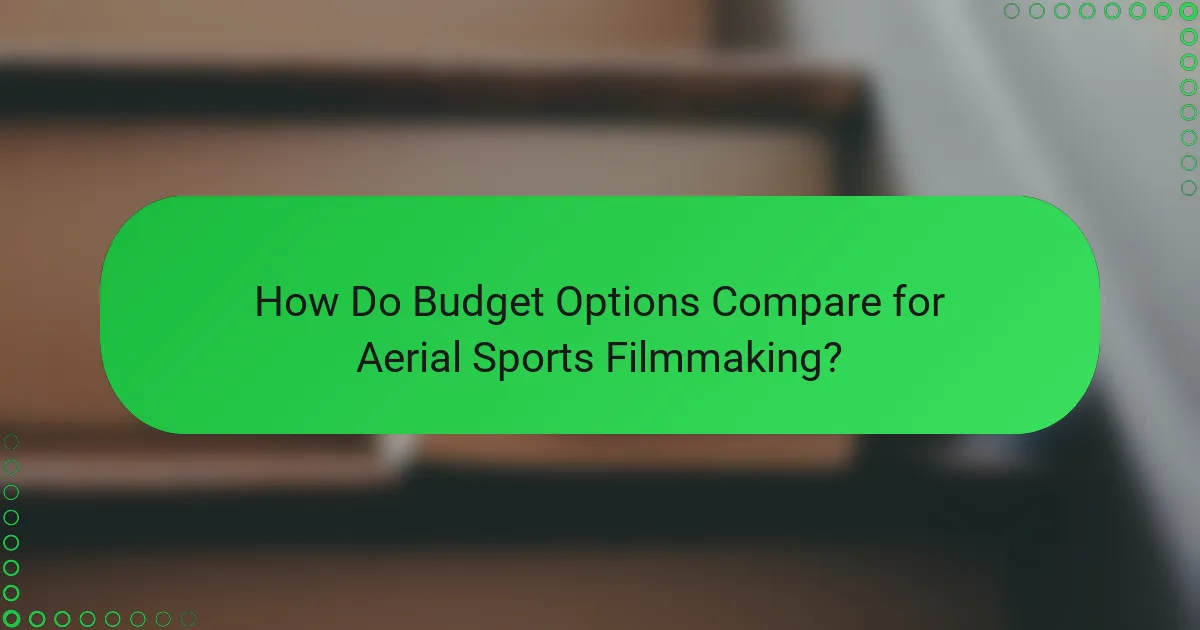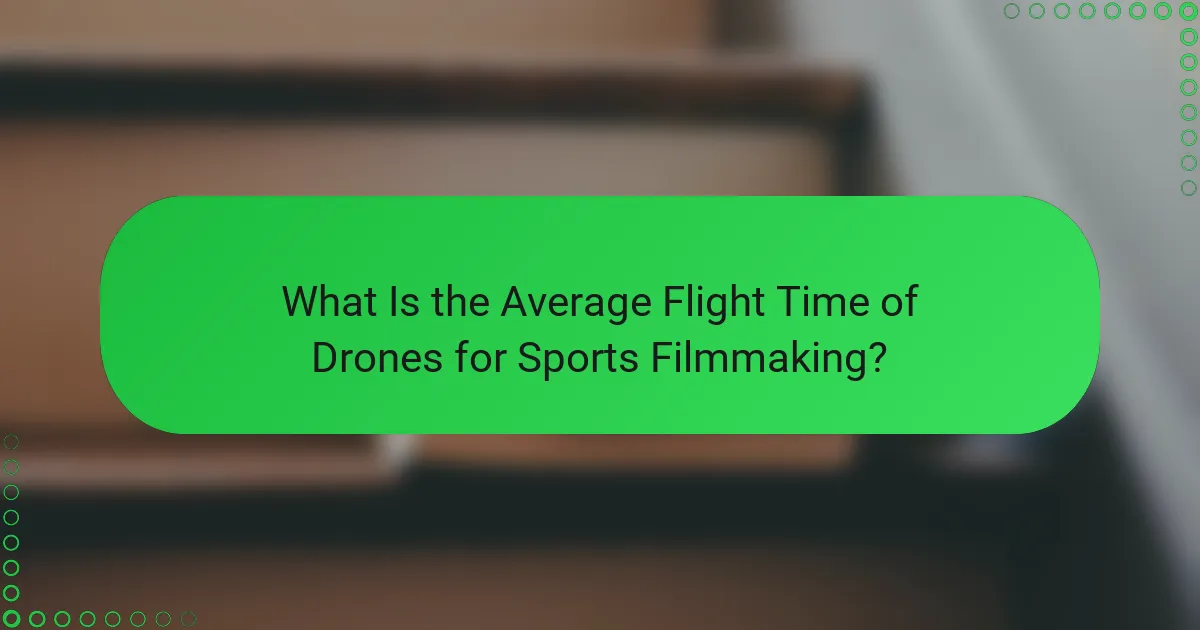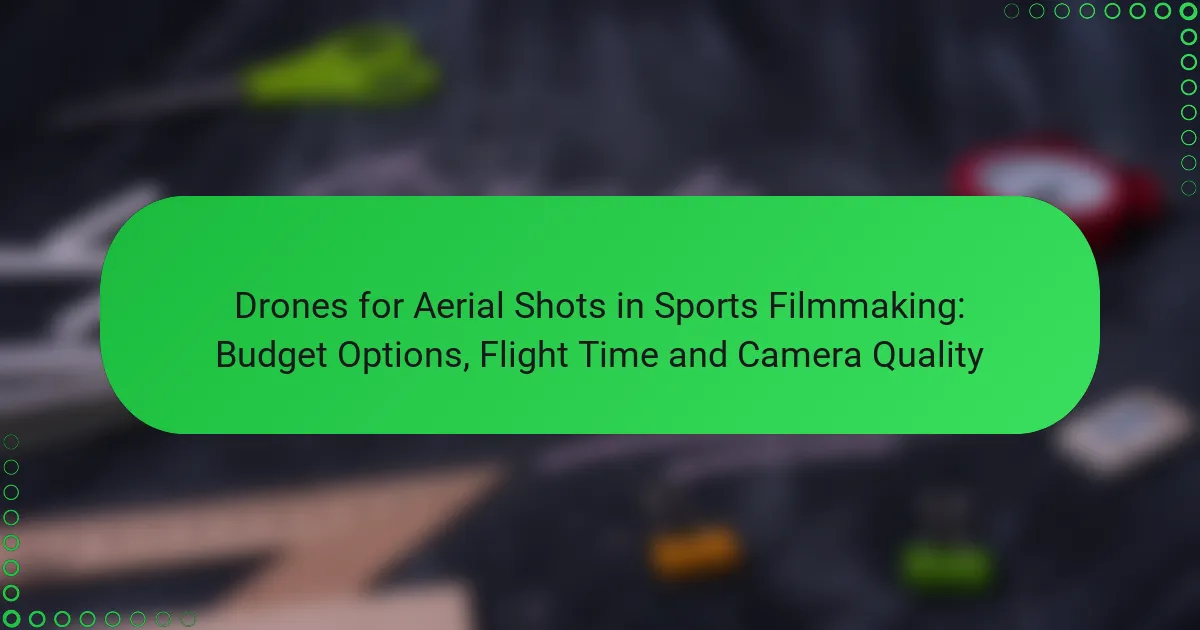In sports filmmaking, the ideal drones for aerial shots strike a balance between affordability, flight time, and camera quality. While budget-friendly options can deliver satisfactory performance, they often involve compromises in features and image quality. Understanding the average flight time of 20 to 30 minutes and the specific needs of your project is essential for selecting the right drone to capture dynamic action from above.

What Are the Best Drones for Aerial Shots in Sports Filmmaking?
The best drones for aerial shots in sports filmmaking combine affordability, flight time, and camera quality. These factors are crucial for capturing dynamic action from above while staying within budget constraints.
DJI Mavic Air 2
The DJI Mavic Air 2 is a popular choice for sports filmmakers due to its excellent balance of features and price. It offers a 4K camera with a 60 fps frame rate, allowing for smooth, high-quality footage. With a flight time of up to 34 minutes, it provides ample opportunity to capture extended sequences.
Consider the intelligent shooting modes, such as ActiveTrack, which can follow moving subjects automatically. This feature is particularly useful in fast-paced sports environments, ensuring you don’t miss critical moments.
Autel Robotics EVO Lite+
The Autel Robotics EVO Lite+ stands out with its impressive camera capabilities, featuring a 1-inch sensor that captures 6K video. This drone is ideal for filmmakers looking for superior image quality in various lighting conditions. Its flight time of around 40 minutes allows for extended shooting sessions.
When using the EVO Lite+, take advantage of its customizable settings to adjust exposure and frame rates, which can enhance the final output, especially in challenging environments like outdoor sports.
Parrot Anafi USA
The Parrot Anafi USA is designed for professional use, featuring a 32x zoom camera that can capture detailed shots from a distance. This drone is particularly useful for sports events where you need to maintain a safe distance from the action. It offers a flight time of approximately 32 minutes.
Its lightweight design and compact size make it easy to transport, which is beneficial for filmmakers who travel frequently to different sporting events. Ensure you familiarize yourself with its advanced features to maximize its potential during shoots.
Skydio 2
The Skydio 2 is renowned for its autonomous flying capabilities, making it an excellent choice for capturing fast-moving sports. It uses advanced AI to navigate obstacles, allowing it to follow athletes seamlessly. With a flight time of about 23 minutes, it’s essential to plan your shots efficiently.
Utilize its tracking features to ensure that the drone remains focused on the subject, even in complex environments. This capability can significantly enhance the storytelling aspect of your sports footage.
DJI Mini 2
The DJI Mini 2 is an affordable option for those new to sports filmmaking. It features a 4K camera and a flight time of up to 31 minutes, making it suitable for capturing high-quality footage without breaking the bank. Its lightweight design allows for easy portability.
While it lacks some advanced features of higher-end models, the Mini 2 is user-friendly and perfect for beginners. Focus on mastering basic flying techniques and camera settings to make the most of this drone in sports settings.

How Do Budget Options Compare for Aerial Sports Filmmaking?
Budget options for aerial sports filmmaking can provide decent quality and functionality, but they come with trade-offs in camera quality, flight time, and features. Understanding these differences helps filmmakers choose the right drone based on their specific needs and budget constraints.
Affordable drones under $500
Drones priced under $500 typically offer basic features suitable for casual sports filming. Models like the Holy Stone HS720 or the Potensic D80 provide decent 1080p cameras and flight times around 10-15 minutes. While these drones are easy to operate, they may lack advanced stabilization and high-resolution capabilities.
When selecting an affordable drone, consider the ease of use and portability. Many of these models are lightweight and compact, making them ideal for quick setups during events. However, be mindful of their limited range and battery life, which can restrict your filming options.
Mid-range drones between $500 and $1000
Mid-range drones offer significant improvements in camera quality and flight performance, making them a better choice for serious sports filmmakers. Options like the DJI Mini SE or the Autel EVO Lite provide 4K video capabilities and flight times of 20-30 minutes. These drones often include advanced features such as GPS tracking and obstacle avoidance.
Investing in a mid-range drone can enhance your filming experience, allowing for more dynamic shots and better image quality. However, ensure that you are familiar with local regulations regarding drone use, as these models may require registration in some areas.
Value for money analysis
When evaluating value for money in drones for aerial sports filmmaking, consider the balance between price, features, and performance. Affordable drones may save you money but often compromise on camera quality and flight stability. In contrast, mid-range options provide better overall performance, making them a worthwhile investment for serious projects.
To maximize your budget, look for drones that offer additional accessories, such as extra batteries or carrying cases, which can enhance usability. Always read user reviews and compare specifications to ensure you are getting the best value for your investment in aerial sports filmmaking.

What Is the Average Flight Time of Drones for Sports Filmmaking?
The average flight time of drones used for sports filmmaking typically ranges from about 20 to 30 minutes. This duration can vary based on the drone model, payload, and environmental conditions, making it essential to choose a drone that meets your specific filming needs.
Flight time of DJI Mavic Air 2
The DJI Mavic Air 2 boasts a flight time of approximately 34 minutes under optimal conditions. This makes it a popular choice among sports filmmakers who require extended aerial coverage without frequent battery changes. However, real-world usage often results in slightly lower flight times due to factors like wind and camera settings.
Flight time of Autel EVO Lite+
The Autel EVO Lite+ offers a flight time of around 40 minutes, which is impressive for a drone in this category. This extended flight capability allows filmmakers to capture more continuous footage during sporting events, reducing the need for quick battery swaps. Like the Mavic Air 2, actual flight times may vary based on usage conditions.
Factors affecting flight time
Battery health is another critical consideration. Older or poorly maintained batteries may not hold a charge as effectively, leading to shorter flight times. To maximize flight duration, ensure batteries are well-maintained and consider investing in additional batteries for extended shooting sessions.

How Important Is Camera Quality in Sports Filmmaking Drones?
Camera quality is crucial in sports filmmaking drones as it directly influences the clarity and detail of the footage captured. High-quality cameras can enhance the viewer’s experience by providing crisp images, which is essential for showcasing fast-paced action and intricate details in sports.
Camera specifications of top drones
When selecting a drone for sports filmmaking, consider key camera specifications such as resolution, sensor size, and lens quality. Popular options like the DJI Mavic Air 2 feature a 1/2-inch sensor and can shoot 4K video at 60 frames per second, while the Autel Robotics EVO Lite+ offers a larger 1-inch sensor for improved low-light performance. These specifications impact the overall image quality significantly.
Additionally, look for drones with adjustable aperture settings, which allow for better control over depth of field and exposure. This flexibility can be particularly useful in dynamic environments typical of sports events.
Impact of camera quality on footage
The quality of the camera affects not only the resolution but also the dynamic range and color accuracy of the footage. Higher-quality cameras can capture a wider range of colors and details in both highlights and shadows, resulting in more visually appealing footage. This is especially important in sports, where lighting conditions can change rapidly.
Moreover, good camera quality can reduce the need for extensive post-production work, saving time and resources. Filmmakers can achieve a more polished look right out of the camera, which is beneficial for quick turnarounds in sports broadcasting.
Comparison of 4K vs 1080p cameras
4K cameras provide four times the resolution of 1080p cameras, resulting in sharper images and more detail, which is advantageous for capturing fast-moving sports action. This higher resolution allows for cropping in post-production without losing image quality, making it a preferred choice for professional filmmakers.
However, 1080p cameras can still produce high-quality footage and may be more budget-friendly. For many amateur filmmakers or those working with limited resources, 1080p can be sufficient, especially for online content where streaming quality may not demand 4K. Ultimately, the choice between 4K and 1080p should consider the intended use, budget, and available editing capabilities.

What Are the Key Features to Consider When Choosing a Drone?
When selecting a drone for aerial shots in sports filmmaking, focus on stability, control features, camera gimbal technology, and overall flight performance. These factors significantly influence the quality of your footage and the ease of operation.
Stability and control features
Stability is crucial for capturing smooth and professional-looking footage, especially in dynamic sports environments. Look for drones equipped with advanced stabilization systems, such as GPS and altitude hold, which help maintain a steady flight path even in windy conditions.
Control features like return-to-home and obstacle avoidance enhance safety and usability. Drones with intuitive remote controls or smartphone apps allow for easier maneuvering, which is beneficial when tracking fast-moving subjects.
Camera gimbal technology
A high-quality gimbal is essential for achieving stable shots while the drone is in motion. A 3-axis gimbal compensates for pitch, roll, and yaw, ensuring that your camera remains level and focused on the action. This is particularly important in sports where quick movements are common.
When evaluating gimbal technology, consider the payload capacity and compatibility with your camera. Some drones come with integrated cameras, while others allow you to mount your own, giving you flexibility in achieving the desired image quality.
